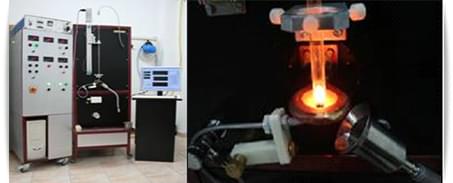EQUIPMENT FOR GLASS-COATED MICRO AND NANOWIRES preparation (International Patents EP, US, CA)
Glass-coated micro-and nanowires are obtained by an improved variant of the Taylor method, which consists of sealing one end of the glass tube in which the master alloy was introduced, heating by induction in high frequency field of the end of the glass tube, where the alloy is placed, up to a temperature at which the alloy molten and the glass becomes soft, and drawing a fibre from the heated end. A lower than atmospheric pressure of argon (Ar) gas is created in the glass tube which will help keep the position of the molten metal at a certain distance above the inductor, maintaining thus the constant temperature of the molten alloy.

Glass-coated micro/nanowires equipment
To ensure the continuity of the process and a uniform thickness of the glass coating, the glass tube moves down with a uniform velocity ranging between 0.5 mm/min and 7 mm/min.
The drawn glass-coated metallic wire is cooled by a laterally directed water jet at about 1 cm below the induction coil to achieve the amorphous state and it is wounded on a rotating spoon. Depending on the type of material and on the process parameters, the diameter of the amorphous metal wires ranges between 2 ÷ 50 μm and the thickness of the glass coating is between 5 and 30 μm.
Technical specifications:
- Winding/drawing speed: up to 500 m/min
- Velocity of glass tube: 0.5 ÷ 7 mm/min
- Depression: 0 - 10 cm - water column
- Generator power: 0 - 10 kW
Services:
- Design, development, and technology transfer of equipment for amorphous and nanocrystalline micro-and nanowires preparation by melt-spinning technique
- Preparation of a wide range of glass-coated micro-and nanowires with different diameters.


